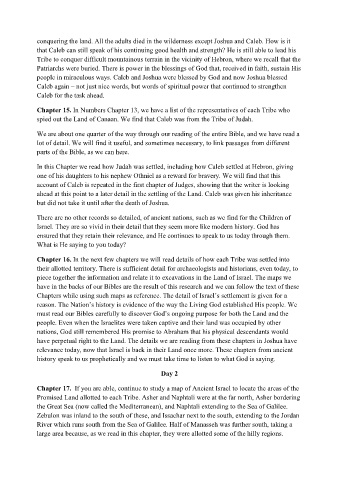Page 150 - Part One
P. 150
conquering the land. All the adults died in the wilderness except Joshua and Caleb. How is it
that Caleb can still speak of his continuing good health and strength? He is still able to lead his
Tribe to conquer difficult mountainous terrain in the vicinity of Hebron, where we recall that the
Patriarchs were buried. There is power in the blessings of God that, received in faith, sustain His
people in miraculous ways. Caleb and Joshua were blessed by God and now Joshua blessed
Caleb again – not just nice words, but words of spiritual power that continued to strengthen
Caleb for the task ahead.
Chapter 15. In Numbers Chapter 13, we have a list of the representatives of each Tribe who
spied out the Land of Canaan. We find that Caleb was from the Tribe of Judah.
We are about one quarter of the way through our reading of the entire Bible, and we have read a
lot of detail. We will find it useful, and sometimes necessary, to link passages from different
parts of the Bible, as we can here.
In this Chapter we read how Judah was settled, including how Caleb settled at Hebron, giving
one of his daughters to his nephew Othniel as a reward for bravery. We will find that this
account of Caleb is repeated in the first chapter of Judges, showing that the writer is looking
ahead at this point to a later detail in the settling of the Land. Caleb was given his inheritance
but did not take it until after the death of Joshua.
There are no other records so detailed, of ancient nations, such as we find for the Children of
Israel. They are so vivid in their detail that they seem more like modern history. God has
ensured that they retain their relevance, and He continues to speak to us today through them.
What is He saying to you today?
Chapter 16. In the next few chapters we will read details of how each Tribe was settled into
their allotted territory. There is sufficient detail for archaeologists and historians, even today, to
piece together the information and relate it to excavations in the Land of Israel. The maps we
have in the backs of our Bibles are the result of this research and we can follow the text of these
Chapters while using such maps as reference. The detail of Israel’s settlement is given for a
reason. The Nation’s history is evidence of the way the Living God established His people. We
must read our Bibles carefully to discover God’s ongoing purpose for both the Land and the
people. Even when the Israelites were taken captive and their land was occupied by other
nations, God still remembered His promise to Abraham that his physical descendants would
have perpetual right to the Land. The details we are reading from these chapters in Joshua have
relevance today, now that Israel is back in their Land once more. These chapters from ancient
history speak to us prophetically and we must take time to listen to what God is saying.
Day 2
Chapter 17. If you are able, continue to study a map of Ancient Israel to locate the areas of the
Promised Land allotted to each Tribe. Asher and Naphtali were at the far north, Asher bordering
the Great Sea (now called the Mediterranean), and Naphtali extending to the Sea of Galilee.
Zebulon was inland to the south of these, and Issachar next to the south, extending to the Jordan
River which runs south from the Sea of Galilee. Half of Manasseh was further south, taking a
large area because, as we read in this chapter, they were allotted some of the hilly regions.

